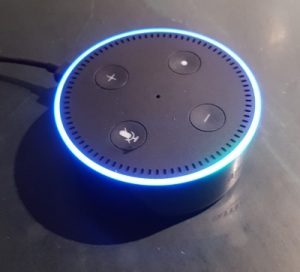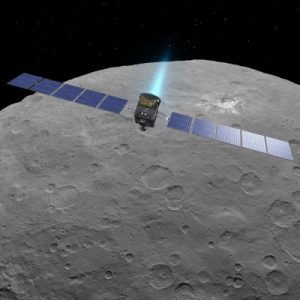This is the third and final part of Left Behind by Events, in which I take a look at my own futuristic writing and try to guess which bits I will have got utterly wrong when somebody looks back at it from a future perspective! But it’s also the first of a few blogs in which I will talk a bit about some of the impressions I got of technical near-future as seen at the annual Microsoft Future Decoded conference that I went to the other day.

So I am tolerably confident about the development of AI. We don’t yet have what I call “personas” with autonomy, emotion, and gender. I’m not counting the pseudo-gender produced by selecting a male or female voice, though actually even that simple choice persuades many people – how many people are pedantic enough to call Alexa “it” rather than “she”? But at the rate of advance of the relevant technologies, I’m confident that we will get there.
I’m equally confident, being an optimistic guy, that we’ll develop better, faster space travel, and have settlements of various sizes on asteroids and moons. The ion drive I posit is one definite possibility: the Dawn asteroid probe already uses this system, though at a hugely smaller rate of acceleration than what I’m looking for. The Hermes, which features in both the book and film The Martian, also employs this drive type. If some other technology becomes available, the stories would be unchanged – the crucial point is that intra-solar-system travel takes weeks rather than months.

I am totally convinced that financial crime will take place! One of the ways we try to tackle it on Earth is to share information faster, so that criminals cannot take advantage of lags in the system to insert falsehoods. But out in the solar system, there’s nothing we can do about time lags. Mars is between 4 and 24 minutes from Earth in terms of a radio or light signal, and there’s nothing we can do about that unless somebody invents a faster-than-light signal. And that’s not in range of my future vision. So the possibility of “information friction” will increase as we spread our occupancy wider. Anywhere that there are delays in the system, there is the possibility of fraud… as used to great effect in The Sting.
Something I have not factored in at all is biological advance. I don’t have cyborgs, or genetically enhanced people, or such things. But I suspect that the likelihood is that such developments will occur well within the time horizon of Far from the Spaceports. Biology isn’t my strong suit, so I haven’t written about this. There’s a background assumption that illness isn’t a serious problem in this future world, but I haven’t explored how that might happen, or what other kinds of medical change might go hand-in-hand with it. So this is almost certainly going to be a miss on my part.
Moving on to points of contact with the conference, there is the question of my personas’ autonomy. Right now, all of our current generation of intelligent assistants – Alexa, Siri, Cortana, Google Home and so on – rely utterly on a reliable internet connection and a whole raft of cloud-based software to function. No internet or no cloud connection = no Alexa.
This is clearly inadequate for a persona like Slate heading out to the asteroid belt! Mitnash is obviously not going to wait patiently for half an hour or so between utterances in a conversation. For this to work, the software infrastructure that imparts intelligence to a persona has to travel along with it. Now this need is already emerging – and being addressed – right now. I guess most of us are familiar with the idea of the Cloud. Your Gmail account, your Dropbox files, your iCloud pictures all exists somewhere out there… but you neither know nor care where exactly they live. All you care is that you can get to them when you want.

But with the emerging “internet of things” that is having to change. Let’s say that a wildlife programme puts a trail camera up in the mountains somewhere in order to get pictures of a snow leopard. They want to leave it there for maybe four months and then collect it again. It’s well out of wifi range. In those four months it will capture say 10,000 short videos, almost all of which will not be of snow leopards. There will be mountain goats, foxes, mice, leaves, moving splashes of sunshine, flurries of rain or snow… maybe the odd yeti. But the memory stick will only hold say 500 video clips. So what do you do? Throw away everything that arrives after it gets full? Overwrite the oldest clips when you need to make space? Arrange for a dangerous and disruptive resupply trip by your mountaineer crew?
Or… and this is the choice being pursued at the moment… put some intelligence in your camera to try to weed out non-snow-leopard pictures. Your camera is no longer a dumb picture-taking device, but has some intelligence. It also makes your life easier when you have recovered the camera and are trying to scan through the contents. Even going through my Grasmere badger-cam vids every couple of weeks involves a lot of deleting scenes of waving leaves!
So this idea is now being called the Cloud Edge. You put some processing power and cleverness out in your peripheral devices, and only move what you really need into the Cloud itself. Some of the time, your little remote widgets can make up their own minds what to do. You can, so I am told, buy a USB stick with trainable neural network on it for sifting images (or other similar tasks) for well under £100. Now, this is a far cry from an independently autonomous persona able to zip off to the asteroid belt, but it shows that the necessary technologies are already being tackled.

I’ve been deliberately vague about how far into the future Far from the Spaceports, Timing, and the sequels in preparation are set. If I had to pick a time I’d say somewhere around the one or two century mark. Although science fact notoriously catches up with science fiction faster than authors imagine, I don’t expect to see much of this happening in my lifetime (which is a pity, really, as I’d love to converse with a real Slate). I’d like to think that humanity from one part of the globe or another would have settled bases on other planets, moons, or asteroids while I’m still here to see them, and as regular readers will know, I am very excited about where AI is going. But a century to reach the level of maturity of off-Earth habitats that I propose seems, if anything, over-optimistic.
That’s it for today – over the next few weeks I’ll be talking about other fun things I learned…
